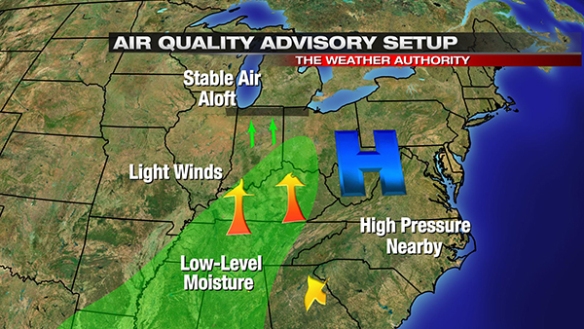The term “Smog Alert” has been a phrase used for decades on days where air quality was relatively poor in Cincinnati. Beginning today, however, the Southwest Ohio Air Quality Agency will no longer issue “Smog Alerts.” Instead, they will issue an “Air Quality Advisory.” This change involves more than just the title of the alert. The chief aim of this rebranding is to re-engage you about local air quality.
The Southwest Ohio Air Quality Agency measures the concentration of the six pollutants to U.S. Environmental Protection Agency health-based standards for Butler, Clermont, Hamilton, and Warren County. Under the current U.S. EPA standards, if ozone or particulate matter causes the Air Quality Index to exceed 100, the Agency will issue an Air Quality Advisory (beginning today). This is a message that encourages at-risk individuals (those with asthma and other pulmonary issues, young children, and older adults) to avoid strenuous outdoor activity until air quality improves.
When an Air Quality Advisory is issued, it will be in effect for Butler, Warren, Hamilton, Clermont, Boone, Kenton, and Campbell County (just like Smog Alerts).
The Air Quality Advisory is issued by Southwest Ohio Air Quality Agency the day before elevated ozone and/or particulate matter levels are anticipated. The decision is made around 2pm (usually Monday through Friday, but occasionally on weekends if ozone or particulate matter levels are forecast to be high) and includes a review of current and historic weather patterns.
Calculating the Air Quality Index is not easy. In fact, it’s horribly messy. The technical explanation how the AQI is calculated is here: http://www.epa.gov/airnow/aqi-technical-assistance-document-dec2013.pdf (beginning on page 16). Before the overall AQI is calculated, the AQI must be calculated for each pollutant (O2, O3, NO2, SO2, PM10, PM2.5). A calculator for doing this can be found at: http://airnow.gov/index.cfm?action=resources.conc_aqi_calc. Again, it’s a total mess. However, once that AQI is measured or forecast, the determination for a “Air Quality Advisory” will be made.
The weather plays an important part of that decision to issue or not issue. Here’s a graphic showing some weather factors that may trap pollutants near the ground and cause an “Air Quality Advisory” day to be issued:
Notice that high dewpoints, a center of high pressure nearby, weak winds, and a temperature inversion (temperature increasing with increasing altitude, creating a stable layer of air aloft) help elevate air pollution levels. With time these conditions change, and air quality levels improve.
The main driver for an elevated AQI in the summer is ozone. The main driver for an elevated AQI in the winter is particulate matter. Smog alerts were almost always issued during the summer in the past; going forward, Air Quality Advisories may be issued at any time of the year, including during the winter.
Air Quality Advisories will likely be issued more frequently than Smog Alerts were. The current national standard for ozone is 75 parts per billion (ppb). The U.S. EPA is proposing a new standard of 70 or 65ppb and possibly 60ppb; the EPA will likely adjust the standard this fall. How many Air Quality Advisories we get will depend on how strict the standard is.
For example, no Smog Alerts were issued in 2013 or 2014. Had the Air Quality Advisory program been in effect those years, an advisory would have been issued 2 days in 2013 and 4 days in 2014 due to ozone levels exceeding the standard of 75ppb:
That’s the current EPA ozone standard. The standard will likely become more strict later this year. Suppose it was set at 70ppb in 2013 and 2014 (like it likely will be later this year); during the last two years, there would have been 31 days with Air Quality Advisories in effect:
Suppose it was even more strict and set at 65ppb. There would have been 109 Air Quality Advisory days in 2013 and 2014:
Lastly, if the EPA had lowered the standard to 60ppb for 2013 and 2014 with the Air Quality Advisory program in effect, an Air Quality Advisory would have been needed 239 days in the last two years:
We are just barely meeting the ozone standard in Cincinnati now:

Courtesy: Southwest Ohio Air Quality Agency
While ozone concentrations in the air we breathe have dropped significantly in the last few decades (the blue line above), we are just under the current standard (the green line above).
Again, this is just for the ozone standard. We also have to meet particulate matter, sulfur dioxide, nitrogen dioxide, and carbon monoxide standards. In addition to ozone, we are barely making sulfur dioxide and some particulate matter standards.
We have a lot of work to do on air quality. I haven’t met a person who doesn’t want cleaner air. All of the same air quality tips you heard for Smog Alerts will apply to Air Quality Advisory days. In case you’ve forgotten them (I understand, it has been a while), here they are:
– Taking the bus, carpooling, biking or walking instead of driving
– Refueling your vehicle after 8 p.m.; do not top off when refueling and tighten the gas cap
– Not idling your vehicle
– Combining trips or eliminating unnecessary vehicle trips
– Keeping your vehicle maintained with properly inflated tires and timely oil changes
– Avoiding use of gasoline-powered lawn equipment on Air Quality Advisory days
– Avoiding use of oil-based paints and stains on Air Quality Advisory days
– Never burning leaves or other yard trimmings
– Always burning clean, seasoned wood in outdoor fire pits, fireplaces and wood stoves
– Not using fire pits or fireplaces for non-essential home heating on Air Quality Advisory days
– Conserving electricity





